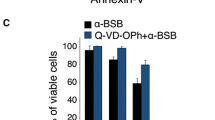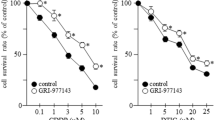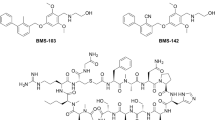Summary
Apomine, a novel bisphosphonate ester, has demonstrated anticancer activity in a variety of cancer cell lines; however, its mechanism of cytotoxicity is not well understood. Previous work has demonstrated that Apomine induces cell death by activation of caspase-3 in several cancer cell types. However, we have demonstrated that Apomine induces cell death in the A375 human melanoma cell line through a novel membrane-mediated mechanism that is independent of caspase-3 activation. This mechanism of membrane lysis may apply to other bisphosphonates and may be an important mechanism for overcoming resistance to apoptosis. Interestingly, Apomine-mediated cell death in the A375 and UACC 3093 human melanoma cell lines is also independent of N-Ras farnesylation, which was a previously described mechanism of action for Apomine in other cancer cell types. These data suggest that Apomine induces cell death through a novel plasma membrane-mediated cytolytic pathway, independent of caspase-3 activation and N-Ras farnesylation.




Similar content being viewed by others
References
Niesor EJ, Flach J, Weinberger C, Bentzen CL (1999) Synthetic farnesoid X receptor (FXR) agonists: a new class of cholesterol synthesis inhibitors and antiproliferative drugs. Drugs of the Future 24:431–438
Roitelman J, Masson D, Avner R, Ammon-Zufferey C, Perez A, Guyon-Gellin Y, Bentzen CL, Niesor EJ (2004) Apomine, a novel hypocholesterolemic agent, accelerates degradation of 3-Hydroxy-3-methylglutaryl-coenzyme a reductase and stimulates low density lipoprotein receptor activity. J Biol Chem 279:6465–6473
Flach J, Antoni I, Villemin P, Bentzen CL, Niesor EJ (2000) The mevalonate/isoprenoid pathway inhibitor apomine (SR-45023A) is antiproliferative and induces apoptosis similar to farnesol. Biochem Biophys Res Commun 270:240–246
Lowe LC, Senaratne SG, Colston KW (2005) Induction of apoptosis in breast cancer cells by apomine is mediated by caspase and p38 mitogen activated protein kinase activation. Biochem Biophys Res Commun 329:772–779
Howard WR, Pospisil JA, Njolito E, Noonan DJ (2000) Catabolites of cholesterol synthesis pathways and forskolin as activators of the farnesoid X-activated nuclear receptor. Toxicol Appl Pharmacol 163:195–202
Martinez JD, Stratagoules ED, LaRue JM, Powell AA, Gause PR, Craven MT, Payne CM, Powell MB, Gerner EW, Earnest DL (1998) Different bile acids exhibit distinct biological effects: the tumor promoter deoxycholic acid induces apoptosis and the chemopreventive agent ursodeoxycholic acid inhibits cell proliferation. Nutr Cancer 31:111–118
Graaf MR, Richel DJ, van Noorden CJ, Guchelaar HJ (2004) Effects of statins and farnesyltransferase inhibitors on the development and progression of cancer. Cancer Treat Rev 30:609–641
Alberts DS, Hallum AV, III, Stratton-Custis M, Garcia DJ, Gleason-Guzman M, Salmon SE, Santabarbara P, Niesor EJ, Floret S, Bentzen CL (2001) Phase I pharmacokinetic trial and correlative in vitro phase II tumor kinetic study of Apomine (SR-45023A), a novel oral biphosphonate anticancer drug. Clin Cancer Res 7:1246–1250
Lewis KD, Thompson JA, Weber JS, Robinson WA, O'day S, Lutzky J, Legha SS, Floret S, Ruvuna F, Gonzalez R (2006) A phase II open-label trial of apomine (SR-45023A) in patients with refractory melanoma. Invest New Drugs 24:89–94
Powell MB, Gause PR, Hyman P, Gregus J, Lluria-Prevatt M, Nagle R, Bowden GT (1999) Induction of melanoma in TPras transgenic mice. Carcinogenesis 20:1747–1753
Powell MB, Alberts DS, Lluria-Prevatt M, Carrier A, Lopez AM, Hersh E, Kinsey A, Smith S, Niesor EJ, Bentzen CL (2002) Preclinical and clinical activity of Apomine, a novel bisphosphonate ester, in the prevention and treatment of melanoma. 2002 AACR Annual Meeting
Kuehl PJ, Angersbach BS, Stratton SP, Myrdal PB (2006) Development of an HPLC method for the analysis of Apomine in a topical cream formulation. J Pharm Biomed Anal 40:975–980
Adjei AA (2001) Blocking oncogenic Ras signaling for cancer therapy. J Natl Cancer Inst 93:1062–1074
Omholt K, Karsberg S, Platz A, Kanter L, Ringborg U, Hansson J (2002) Screening of N-ras codon 61 mutations in paired primary and metastatic cutaneous melanomas: mutations occur early and persist throughout tumor progression. Clin Cancer Res 8:3468–3474
Goydos JS, Mann B, Kim HJ, Gabriel EM, Alsina J, Germino FJ, Shih W, Gorski DH (2005) Detection of B-RAF and N-RAS mutations in human melanoma. J Am Coll Surg 200:362–370
Eskandarpour M, Kiaii S, Zhu C, Castro J, Sakko AJ, Hansson J (2005) Suppression of oncogenic NRAS by RNA interference induces apoptosis of human melanoma cells. Int J Cancer 115:65–73
Davies H, Bignell GR, Cox C, Stephens P, Edkins S, Clegg S, Teague J, Woffendin H, Garnett MJ, Bottomley W, Davis N, Dicks E, Ewing R, Floyd Y, Gray K, Hall S, Hawes R, Hughes J, Kosmidou V, Menzies A, Mould C, Parker A, Stevens C, Watt S, Hooper S, Wilson R, Jayatilake H, Gusterson BA, Cooper C, Shipley J, Hargrave D, Pritchard-Jones K, Maitland N, Chenevix-Trench G, Riggins GJ, Bigner DD, Palmieri G, Cossu A, Flanagan A, Nicholson A, Ho JW, Leung SY, Yuen ST, Weber BL, Seigler HF, Darrow TL, Paterson H, Marais R, Marshall CJ, Wooster R, Stratton MR, Futreal PA (2002) Mutations of the BRAF gene in human cancer. Nature 417:949–954
Thompson FH, Emerson J, Olson S, Weinstein R, Leavitt SA, Leong SP, Emerson S, Trent JM, Nelson MA, Salmon SE (1995) Cytogenetics of 158 patients with regional or disseminated melanoma. Subset analysis of near-diploid and simple karyotypes. Cancer Genet Cytogenet 83:93–104
Guan XY, Zhang H, Yang JM, Wang J, Taetle R, Meltzer PS, Trent JM (1998) Detection of chromosome 6 abnormalities in melanoma cell lines by chromosome arm painting probes. Cancer Genet Cytogenet 107:89–92
Mosmann T (1983) Rapid colorimetric assay for cellular growth and survival: application to proliferation and cytotoxicity assays. J Immunol Methods 65:55–63
Mayr CA, Sami SM, Dorr RT (1997) In vitro cytotoxicity and DNA damage production in Chinese hamster ovary cells and topoisomerase II inhibition by 2-[2′-(dimethylamino)ethyl]-1, 2-dihydro-3H-dibenz[de,h]isoquinoline-1,3-diones with substitutions at the 6 and 7 positions (azonafides). Anticancer Drugs 8:245–256
Bolick SC, Landowski TH, Boulware D, Oshiro MM, Ohkanda J, Hamilton AD, Sebti SM, Dalton WS (2003) The farnesyl transferase inhibitor, FTI-277, inhibits growth and induces apoptosis in drug-resistant myeloma tumor cells. Leukemia 17:451–457
Dignam JD, Lebovitz RM, Roeder RG (1983) Accurate transcription initiation by RNA polymerase II in a soluble extract from isolated mammalian nuclei. Nucleic Acids Res 11:1475–1489
End DW, Smets G, Todd AV, Applegate TL, Fuery CJ, Angibaud P, Venet M, Sanz G, Poignet H, Skrzat S, Devine A, Wouters W, Bowden C (2001) Characterization of the antitumor effects of the selective farnesyl protein transferase inhibitor R115777 in vivo and in vitro. Cancer Res 61:131–137
Naito K, He Q, Skog S, Tribukait B, Andersson L, Hisazumi H (1989) Effects of adriamycin and hyperthermia on cellular uptake of [3H]thymidine and its significance for the incorporation into DNA. Int J Hyperthermia 5:329–340
Rieber M, Bacalao J, Alonso G (1975) Cholera toxin effects on cell growth accompanied by selective alterations in metabolite uptake and modification of cell surface proteins. Cancer Res 35:3009–3013
Rieber M, Bacalao J (1976) Selective modification of cell surface proteins and thymidine transport in hamster cells exposed to cholera toxin. J Supramol Struct 4:127–132
Korzeniewski C, Callewaert DM (1983) An enzyme-release assay for natural cytotoxicity. J Immunol Methods 64:313–320
Decker T, Lohmann-Matthes ML (1988) A quick and simple method for the quantitation of lactate dehydrogenase release in measurements of cellular cytotoxicity and tumor necrosis factor (TNF) activity. J Immunol Methods 115:61–69
Nishioka D, Killian CE, Chacon CT, Sgagias MK (1984) Increased uptake of thymidine in the activation of sea urchin eggs. III. Effects of aphidicolin. J Cell Physiol 118:27–33
Skog S, He Q, Tribukait B (1990) Lack of correlation between thymidine kinase activity and changes of DNA synthesis with tumour age: an in vivo study in Ehrlich ascites tumour. Cell Tissue Kinet 23:603–617
Holstein SA, Wohlford-Lenane CL, Hohl RJ (2002) Isoprenoids influence expression of Ras and Ras-related proteins. Biochemistry 41:13698–13704
Akare S, Martinez JD (2005) Bile acid induces hydrophobicity-dependent membrane alterations. Biochim Biophys Acta 1735:59–67
LaRue JM, Stratagoules ED, Martinez JD (2000) Deoxycholic acid-induced apoptosis is switched to necrosis by bcl-2 and calphostin C. Cancer Lett 152:107–113
Williams KR (2004) The bisphosphonate story: From detergents to bone disease. J Chem Educ 81:1406–1407
Acknowledgments
These studies were supported by Grant PHS CA27502 and CA23074 from the National Institutes of Health, Bethesda, MD. The authors would like to thank Pam M. Pollock, Ph.D., for the sequencing of N-Ras in the UACC 3093 human melanoma cell line and Terry H. Landowski, Ph.D., for critical reading and editing of this manuscript.
Author information
Authors and Affiliations
Corresponding author
Rights and permissions
About this article
Cite this article
Pourpak, A., Dorr, R.T., Meyers, R.O. et al. Cytotoxic activity of Apomine is due to a novel membrane-mediated cytolytic mechanism independent of apoptosis in the A375 human melanoma cell line. Invest New Drugs 25, 107–114 (2007). https://doi.org/10.1007/s10637-006-9015-6
Received:
Accepted:
Published:
Issue Date:
DOI: https://doi.org/10.1007/s10637-006-9015-6




